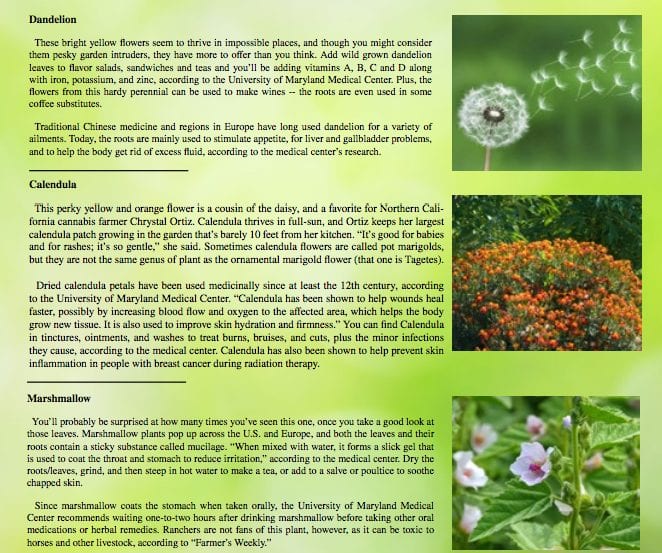
In your backyard. In the cracks of the sidewalk. In untended fields. Weeds find their way into every nook and cranny, sometimes traveling across the globe to spread their progeny. But cannabis isn’t the only weed with healing properties. Here are three common weeds whose benefits extend far beyond the compost bin.
 Dandelion
Dandelion
These bright yellow flowers seem to thrive in impossible places, and though you might consider them pesky garden intruders, they have more to offer than you think. Add wild grown dandelion leaves to flavor salads, sandwiches and teas and you’ll be adding vitamins A, B, C and D along with iron, potassium, and zinc, according to the University of Maryland Medical Center. Plus, the flowers from this hardy perennial can be used to make wines — the roots are even used in some coffee substitutes.
Traditional Chinese medicine and regions in Europe have long used dandelion for a variety of ailments. Today, the roots are mainly used to stimulate appetite, for liver and gallbladder problems, and to help the body get rid of too much fluid, according to the medical center’s research.
Calendula
This perky yellow and orange flower is a cousin of the daisy and a favorite for Northern California cannabis farmer Chrystal Ortiz. Calendula thrives in full-sun, and Ortiz keeps her largest calendula patch growing in the garden that’s barely 10 feet from her kitchen. “It’s good for babies and for rashes; it’s so gentle,” she said. Sometimes calendula flowers are called pot marigolds, but they are not the same genus of plant as the ornamental marigold flower (that one is Tagetes).
Dried calendula petals have been used medicinally since at least the 12th century, according to the University of Maryland Medical Center. “Calendula has been shown to help wounds heal faster, possibly by increasing blood flow and oxygen to the affected area, which helps the body grow new tissue. It is also used to improve skin hydration and firmness.” You can find Calendula in tinctures, ointments, and washes to treat burns, bruises, and cuts, plus the minor infections they cause, according to the medical center. Calendula has also been shown to help prevent skin inflammation in people with breast cancer during radiation therapy.
Calendula flower petals can make a nice addition to a fresh salad or, when dried, a tea. Applying calendula directly to the affected skin as a poultice, salve or ointment, seems to have the most benefit.
What’s a poultice?
It’s an easy-to-make paste of medicinal herbs, with or without other elements.
- Grind/crush herbs (fresh or dry)
- Mix with water to form a thick paste
- Cold water for inflammation
- Hot water for drawing out or removing an abscess
- Apply directly to skin and wrap with a waterproof bandage. Alternatively, place paste wrapped in cheesecloth on affected skin.
Source: TheHerbalAcademy.com
Marshmallow
You’ll probably be surprised at how many times you’ve seen this one, once you take a good look at those leaves. Marshmallow plants pop up across the U.S. and Europe, and both the leaves and their roots contain a sticky substance called mucilage. “When mixed with water, it forms a slick gel that is used to coat the throat and stomach to reduce irritation,” according to the medical center. Dry the roots/leaves, grind, and then steep in hot water to make a tea, or add to a salve or poultice to soothe chapped skin.
Since marshmallow coats the stomach when taken orally, the University of Maryland Medical Center recommends waiting one-to-two hours after drinking marshmallow before taking other oral medications or herbal remedies. Ranchers are not fans of this plant, however, as it can be toxic to horses and other livestock, according to “Farmer’s Weekly.”
Marshmallow has been used for centuries by Egyptians, Chinese and Syrians, but few scientific studies have explored its uses. However, one of the medical center’s recent studies showed marshmallow preparations help soothe irritated mucous membranes due to: asthma, bronchitis, common cold/sore throat, cough, inflammatory bowel diseases, indigestion, stomach ulcers, and skin inflammation.



Leave a Reply